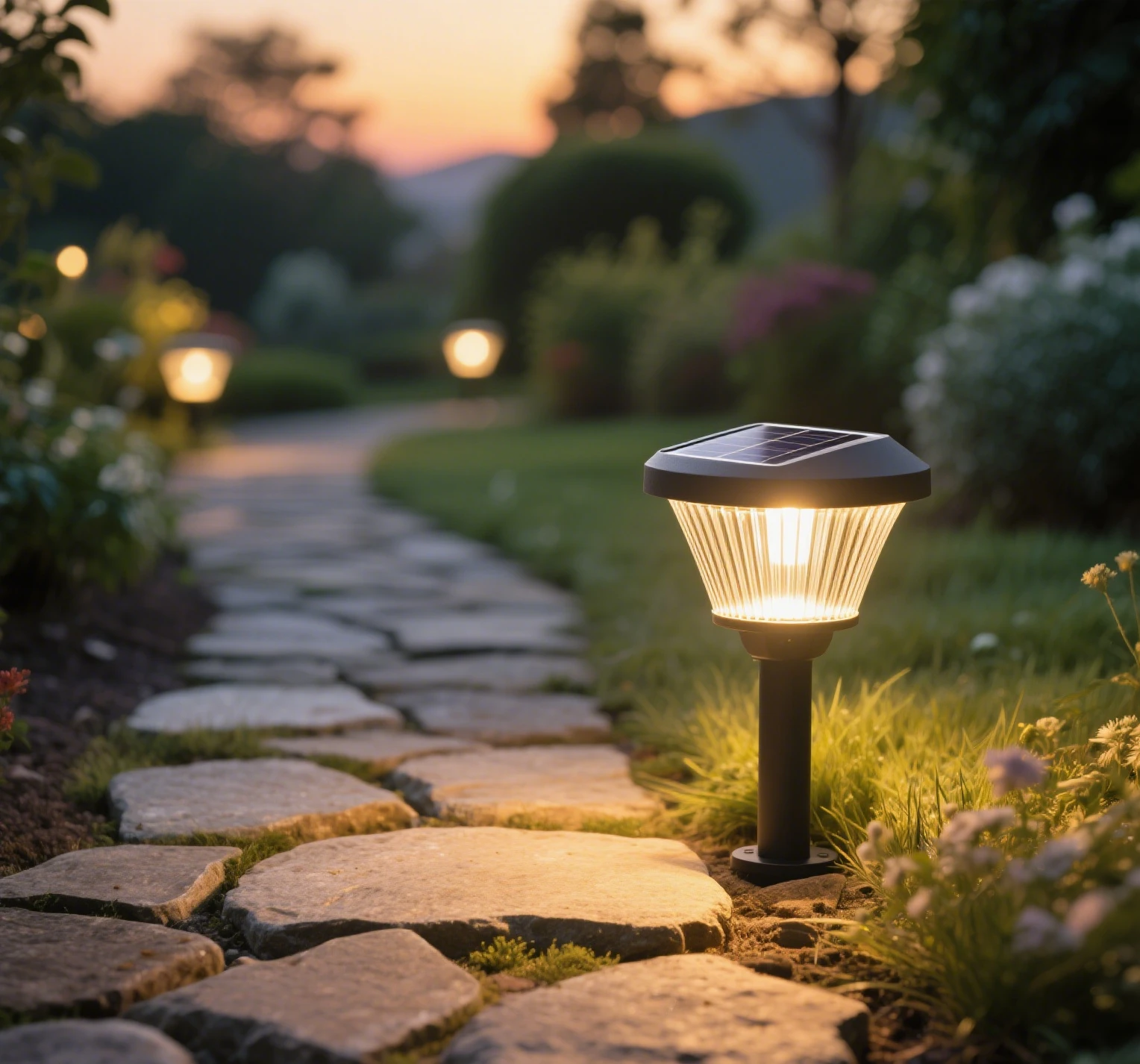Outdoor solar lights are a popular choice for eco-conscious homeowners looking to illuminate their gardens, pathways, or driveways without increasing energy bills. These lights rely on rechargeable batteries to store solar energy captured during the day, powering solar LED lights at night. A common question arises: can you use regular batteries in outdoor solar lights instead of the specialized rechargeable batteries they typically come with? This article explores the feasibility, risks, benefits, and best practices for using regular batteries in solar-powered outdoor lighting, providing a comprehensive guide to help you make informed decisions.

Understanding How Outdoor Solar Lights Work
To answer whether regular batteries can be used, it’s essential to understand the components of a solar lighting system. Outdoor solar lights typically consist of:
- Solar Panels: These convert sunlight into electricity, charging the battery during the day.
- Rechargeable Batteries: Usually nickel-metal hydride (NiMH) or lithium-ion, these store energy for nighttime use.
- LED Bulbs: Solar LED lights are energy-efficient, maximizing the use of stored power.
- Charge Controller: This regulates energy flow to prevent overcharging or discharging, protecting the battery.
- Photoresistor or Timer: These ensure the light activates only at night.
Most solar outdoor lighting systems are designed to work with rechargeable batteries, such as NiMH AA or AAA batteries, because they can handle the frequent charge-discharge cycles of solar energy systems. Regular batteries, like alkaline or zinc-carbon, are not designed for recharging, which raises compatibility concerns.
Can Regular Batteries Be Used in Outdoor Solar Lights?
Technically, regular batteries (e.g., alkaline AA or AAA) can be used in some outdoor solar lights, especially if they match the voltage and size of the original rechargeable batteries (typically 1.2V for NiMH or 3.7V for lithium-ion). Many solar garden lights use standard AA or AAA slots, making it possible to insert regular batteries as a temporary replacement. However, there are significant drawbacks and risks to consider.
Why Regular Batteries Are Not Ideal
- Non-Rechargeable Design: Alkaline regular batteries are not built for the charge-discharge cycles of solar-powered outdoor lighting. Attempting to recharge them in a solar lighting system can cause leakage, overheating, or even explosions, posing safety hazards.
- Reduced Efficiency: Regular batteries have a higher nominal voltage (1.5V vs. 1.2V for NiMH), which may disrupt the light’s circuitry, leading to dimmer output or inconsistent performance in solar LED lights.
- Short Lifespan: Unlike rechargeable batteries, which can handle 500–1000 cycles, regular batteries deplete quickly in solar outdoor lighting, requiring frequent replacements and increasing costs.
- Environmental Impact: Regular batteries are less eco-friendly, as they are disposed of more often than rechargeable ones, contributing to e-waste. A 2024 environmental study estimated that improper battery disposal accounts for 10% of household hazardous waste.
When Regular Batteries Might Work
In emergencies, regular batteries can serve as a temporary fix for solar garden lights or solar pathway lights that have failed due to dead rechargeable batteries. For example, if you’re hosting an outdoor event and need immediate illumination, swapping in alkaline batteries can keep your solar-powered lights running for a night or two. However, this is not a long-term solution, as regular batteries will drain quickly and may damage the light’s internal components over time.
Risks of Using Regular Batteries in Solar Lights
Using regular batteries in outdoor solar lights comes with several risks:
- Circuit Damage: The higher voltage of regular batteries (1.5V vs. 1.2V) can overload the solar lighting system’s circuitry, especially in low-cost models with minimal voltage regulation.
- Battery Leakage: Non-rechargeable batteries may leak corrosive chemicals when exposed to the charging cycles of solar panels, damaging the light’s battery compartment.
- Safety Hazards: Attempting to recharge regular batteries in a solar-powered outdoor lighting system can lead to overheating or chemical reactions, posing fire risks.
- Performance Issues: Regular batteries may not provide consistent power, resulting in dim or flickering solar LED lights, reducing the effectiveness of solar security lights or solar pathway lights.
To mitigate these risks, always check the manufacturer’s specifications. Some solar outdoor lights, like those from Bitpott, include warnings against using non-rechargeable batteries to prevent damage.
Best Practices for Battery Use in Outdoor Solar Lights
To ensure optimal performance and longevity for your outdoor solar lights, follow these best practices:
1. Use Rechargeable Batteries Designed for Solar Lights
Opt for NiMH or lithium-ion batteries specifically designed for solar lighting systems. NiMH batteries (1.2V, AA or AAA) are common in solar garden lights and offer 500–1000 charge cycles. Lithium-ion batteries (3.7V) are used in high-performance solar security lights and provide longer lifespans and better cold-weather performance. For example, a 2000mAh NiMH battery can power a solar LED light for 8–10 hours per charge.
2. Match Voltage and Size
If you must use regular batteries temporarily, ensure they match the voltage and size of the original batteries. For instance, replacing a 1.2V NiMH AA with a 1.5V alkaline AA may work briefly but should be avoided for long-term use.
3. Check Compatibility
Consult the user manual or manufacturer’s website to confirm battery requirements. Some solar-powered lights have built-in safeguards that prevent damage from regular batteries, but most do not.
4. Monitor Battery Health
Rechargeable batteries typically last 2–5 years in solar outdoor lighting. Replace them when they no longer hold a charge, indicated by dim or short-lived illumination. Avoid letting batteries sit uncharged for long periods, as this can reduce their capacity.
5. Proper Disposal
Dispose of both regular batteries and rechargeable batteries responsibly. Many communities offer recycling programs for batteries to prevent environmental harm. According to the EPA, recycling batteries reduces landfill waste by up to 90% for certain materials.

Alternatives to Regular Batteries
Instead of using regular batteries, consider these alternatives for outdoor solar lights:
- High-Capacity Rechargeable Batteries: Upgrade to high-capacity NiMH batteries (e.g., 2500mAh) for longer runtime in solar pathway lights or solar floodlights.
- Lithium-Ion Batteries: For solar security lights, lithium-ion batteries offer better efficiency and durability, especially in cold climates.
- Solar Battery Chargers: Use a dedicated solar battery charger to recharge NiMH or lithium-ion batteries externally, ensuring they’re always ready for use.
- Hybrid Solar Lights: Some modern solar-powered outdoor lighting systems, like those from Bitpott, support both solar and USB charging, providing a backup option during prolonged cloudy weather.
Tips for Maximizing Solar Light Performance
To get the most out of your outdoor solar lights, whether using rechargeable or regular batteries temporarily:
- Optimize Solar Panel Placement: Position solar panels to receive 6–8 hours of direct sunlight daily, ideally at an angle matching your latitude (e.g., 40 degrees for many U.S. regions). Clean panels monthly to remove dirt, which can reduce efficiency by 15–20%.
- Choose Energy-Efficient LEDs: Solar LED lights with high lumens-per-watt ratings maximize battery life. For example, a 5W LED can produce 500 lumens, sufficient for solar garden lights.
- Use Motion Sensors: Solar motion sensor lights conserve battery power by activating only when needed, ideal for solar security lights.
- Store Batteries Properly: During winter or long periods of non-use, remove batteries from solar-powered lights and store them in a cool, dry place to prevent degradation.
Unique Considerations for Battery Management
For a standout approach, consider integrating smart technology into your solar lighting system. Some solar outdoor lights now feature app-controlled battery monitoring, allowing you to track charge levels and performance. For instance, Bitpott’s smart solar security lights send alerts when batteries need replacement, ensuring consistent operation.
Another creative solution is to pair solar-powered outdoor lighting with a small backup solar charger. This setup, popular among DIY enthusiasts, uses a secondary solar panel to charge spare batteries, ensuring uninterrupted lighting during cloudy periods. This approach enhances reliability without resorting to regular batteries.
Environmental and Cost Considerations
Using rechargeable batteries in outdoor solar lights is more cost-effective and environmentally friendly than regular batteries. A single NiMH battery can replace hundreds of alkaline batteries over its lifespan, saving $50–100 annually for a typical solar garden lighting setup. Additionally, solar energy reduces reliance on fossil fuels, with a single solar-powered light saving approximately 30–50 kWh per year compared to traditional lighting.
However, regular batteries may be a short-term solution in emergencies, such as power outages or urgent lighting needs. If you choose this route, opt for high-quality alkaline batteries from reputable brands to minimize risks.
Conclusion
While regular batteries can be used in outdoor solar lights as a temporary fix, they are not recommended for long-term use due to safety risks, reduced efficiency, and environmental concerns. For optimal performance, invest in rechargeable NiMH or lithium-ion batteries designed for solar lighting systems. By choosing the right batteries, maintaining your solar panels, and following best practices, you can ensure your solar-powered outdoor lighting—whether solar garden lights, solar pathway lights, or solar security lights—remains reliable, cost-effective, and eco-friendly. Embrace the power of solar energy and make informed battery choices to illuminate your outdoor spaces sustainably.


Leave a Reply